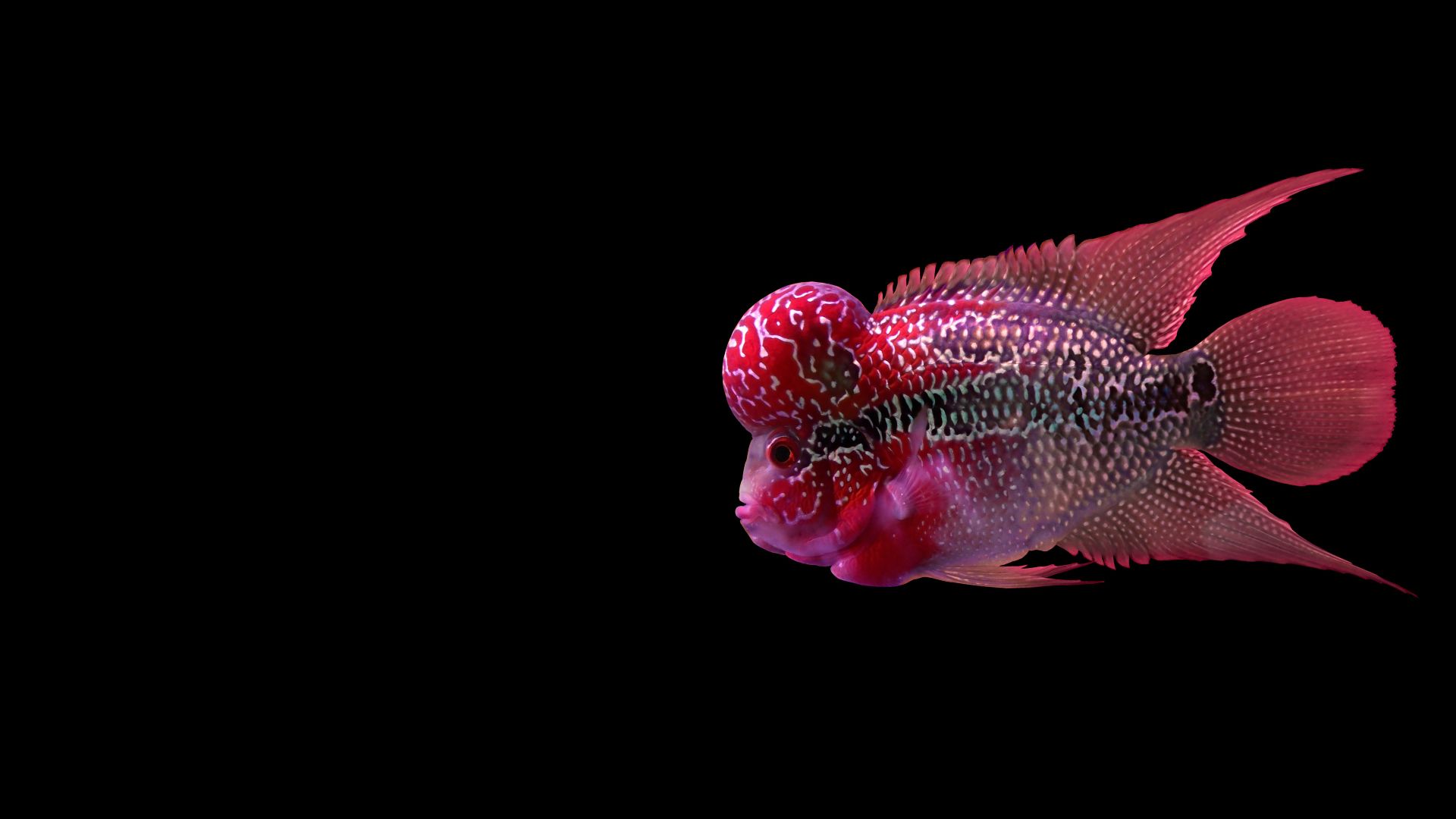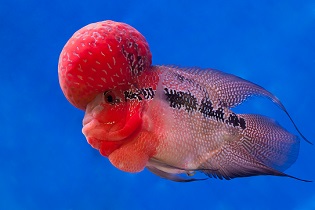
Flowerhorn Cichlid
Scientific name: Hybrid species (no official scientific name)
The Flowerhorn Cichlid is a unique and captivating freshwater fish known for its vivid colors, striking patterns, and the prominent nuchal hump (referred to as a “kok”) on its head.
Originating from selective breeding of various South American cichlid species, the Flowerhorn is a man-made hybrid that has gained immense popularity in the aquarium hobby, especially in Asian countries where it is often associated with good luck and prosperity.
IUCN Red List of Threatened Species : Not Applicable
Flowerhorn Cichlids are known for their territorial and aggressive behavior. They require large aquariums with robust filtration systems due to their size and the amount of waste they produce. A sparsely decorated tank with sturdy hiding spots made from rocks or driftwood is ideal, as they tend to rearrange the tank and can uproot plants. Substrate should be smooth to prevent injuries, and decorations should be securely placed to prevent tipping.
They are omnivorous with a preference for high-protein diets. Feeding a variety of high-quality pellets formulated for cichlids, along with occasional live or frozen foods like shrimp, worms, and insects, is essential for their health and to enhance their coloration.

Navite Location
Developed through selective breeding in Malaysia, Thailand, and Taiwan in the late 1990s
Varieties
Kamfa / Zhen Zhu / Golden Monkey / Thai Silk / Golden Base / King Kamfa / Super Red Dragon
Suggested Tank Mates
Due to their aggressive and territorial nature, it’s often recommended to keep Flowerhorn Cichlids alone. However, if tank mates are desired, they should be large, robust fish that can hold their own.
Diet
High-quality cichlid pellets (enhanced for color and kok development) / Live or frozen foods (shrimp, earthworms, mealworms, crickets) / Occasional vegetables (peas, spinach) / Avoid feeder fish due to disease risk
Breeding
Breeding Flowerhorn Cichlids can be challenging due to their hybrid nature and aggressive behavior. Males are often highly aggressive towards females, so a divider is often used during the breeding process to protect the female.
Lifespan
10–12 years with proper care
Size
Average – 30 cm (12 inches) in length / Some can grow up to 40 cm (16 inches)
Minimum Tank Size
75 gallons (284 liters) for a single adult
Optimum Tank Temperature
26°C to 30°C (79°F to 86°F)
Ideal pH Level
7.0 to 8.0
Water Hardness
8 – 20 dGH (moderately hard to hard water)
Common Health Issues
Hole-in-the-Head Disease (Hexamitiasis) / Ich (White Spot Disease) / Fin Rot / Parasitic Infections / Obesity due to overfeeding / Swim Bladder Disease / Stress-related illnesses due to poor water quality or inadequate tank conditions
Interesting facts
Hybrid Origin
Flowerhorns are not found in the wild; they were created by crossbreeding various cichlid species, including the Trimac Cichlid (Amphilophus trimaculatus) and the Red Devil Cichlid (Amphilophus labiatus).
Symbol of Luck
In some Asian cultures, Flowerhorns are considered to bring good luck and fortune, especially those with markings resembling Chinese characters.
Interactive Behavior
They are known to interact with their owners, often following movements outside the tank and showing excitement during feeding times.
Kok Development
The size of the nuchal hump (kok) is often seen as a sign of health and vitality. Specialized diets and optimal water conditions can enhance kok size.
Color Changes
Flowerhorns can change color based on mood, health, and environmental factors. Bright coloration is typically a sign of good health.
Flowerhorn Cichlid FAQ’s
Do Flowerhorn Cichlids Recognize Their Owners?
Yes, Flowerhorns are intelligent fish that can recognize their owners. They often display interactive behaviors, such as following movements outside the tank and responding excitedly during feeding times.
Why Is My Flowerhorn Cichlid Losing Color?
Color loss can be a sign of stress, illness, or poor water conditions. Factors such as inadequate diet, inappropriate water parameters, or the presence of disease can affect coloration. Regular monitoring of water quality and ensuring a balanced diet can help maintain vibrant colors.
Do Flowerhorn Cichlids Need a Heater?
Yes, Flowerhorns are tropical fish that require warm water temperatures between 26°C to 30°C (79°F to 86°F). A reliable heater is essential to maintain the appropriate temperature range
Are Flowerhorn Cichlids Suitable for Beginners?
Due to their size, specific care requirements, and aggressive behavior, Flowerhorns are better suited for intermediate to experienced aquarists. They require large tanks, robust filtration, and careful management of water parameters.
How Do You Enhance the Kok Size in Flowerhorns?
The size of the kok can be influenced by genetics, diet, and overall health. Feeding high-quality foods rich in protein and certain nutrients, maintaining optimal water conditions, and reducing stress can promote kok development. Some hobbyists use specific supplements or foods marketed for kok enhancement, but it’s important to ensure these are safe and nutritious.
Are Flowerhorn Cichlids Illegal Anywhere?
Due to concerns about invasive species, the importation and ownership of Flowerhorns are restricted or banned in some regions. Always check local regulations before acquiring a Flowerhorn Cichlid.
